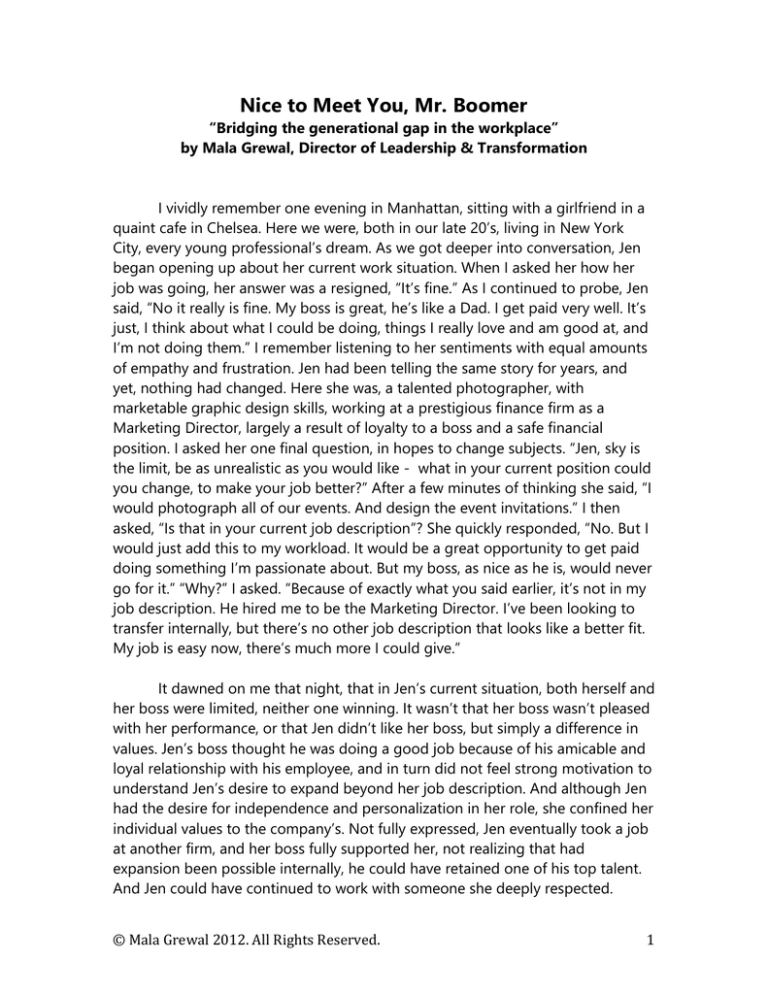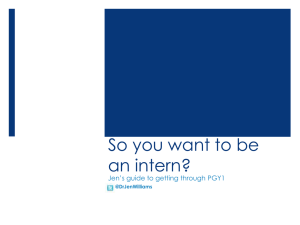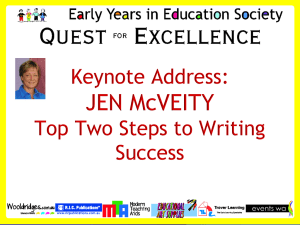
Nice to Meet You, Mr. Boomer
“Bridging the generational gap in the workplace”
by Mala Grewal, Director of Leadership & Transformation
I vividly remember one evening in Manhattan, sitting with a girlfriend in a
quaint cafe in Chelsea. Here we were, both in our late 20’s, living in New York
City, every young professional’s dream. As we got deeper into conversation, Jen
began opening up about her current work situation. When I asked her how her
job was going, her answer was a resigned, “It’s fine.” As I continued to probe, Jen
said, “No it really is fine. My boss is great, he’s like a Dad. I get paid very well. It’s
just, I think about what I could be doing, things I really love and am good at, and
I’m not doing them.” I remember listening to her sentiments with equal amounts
of empathy and frustration. Jen had been telling the same story for years, and
yet, nothing had changed. Here she was, a talented photographer, with
marketable graphic design skills, working at a prestigious finance firm as a
Marketing Director, largely a result of loyalty to a boss and a safe financial
position. I asked her one final question, in hopes to change subjects. “Jen, sky is
the limit, be as unrealistic as you would like - what in your current position could
you change, to make your job better?” After a few minutes of thinking she said, “I
would photograph all of our events. And design the event invitations.” I then
asked, “Is that in your current job description”? She quickly responded, “No. But I
would just add this to my workload. It would be a great opportunity to get paid
doing something I’m passionate about. But my boss, as nice as he is, would never
go for it.” “Why?” I asked. “Because of exactly what you said earlier, it’s not in my
job description. He hired me to be the Marketing Director. I’ve been looking to
transfer internally, but there’s no other job description that looks like a better fit.
My job is easy now, there’s much more I could give.”
It dawned on me that night, that in Jen’s current situation, both herself and
her boss were limited, neither one winning. It wasn’t that her boss wasn’t pleased
with her performance, or that Jen didn’t like her boss, but simply a difference in
values. Jen’s boss thought he was doing a good job because of his amicable and
loyal relationship with his employee, and in turn did not feel strong motivation to
understand Jen’s desire to expand beyond her job description. And although Jen
had the desire for independence and personalization in her role, she confined her
individual values to the company’s. Not fully expressed, Jen eventually took a job
at another firm, and her boss fully supported her, not realizing that had
expansion been possible internally, he could have retained one of his top talent.
And Jen could have continued to work with someone she deeply respected.
© Mala Grewal 2012. All Rights Reserved.
1
As months went on, more conversations ensued. I came to realize that
unfortunately, Jen’s frustrated state of stagnation and limitation was not only
common, but the standard amongst young professionals. Everyone seemed to be
somewhat disenchanted with their work, going through the motions to make
their bosses happy, some even actively acting out his or her unhappiness by
taking extra “sick” days and booking longer vacations. Few felt authentic passion
and connectivity to their managers and themselves.
A study by Towers Perrins in 2008 described this scenario as “the
engagement gap”. Of their surveys 90,000 respondents, only 21% worldwide are
engaged in their work, meaning they’re willing to go the extra mile to help their
company succeed. According to a human relations survey conducted in 2012 by
Bersin & Associates, employee engagement is the foremost human resource
issue for HR leaders. Annual losses in lost productivity from ‘actively disengaged’
employees has risen to $328 billion in 2012.1
These findings beg the following question: why is this disengagement
happening now?
The answer is something I refer to as, the Generational Gap. Active
disengagement at work is often a result of the values disparity between Baby
Boomers, Gen Xers, and Millennials. The majority of our corporations in the
United States are designed to the values of Baby Boomers like Jen’s boss, not to
those of Gen Xers and Millennials, like Jen. The problem with this reality is that
Gen Xers and Millennials are the future of our corporations.
To prepare for profitable futures, it is imperative companies find a way to
create mutually beneficial relationships between the generations. As a Talent
Catalyst, I spend my career bridging the gap between disengaged and actively
engaged individuals, connecting them to their highest potential in a measurable
way. I offer the following introductory advice to the generations by highlighting
values2 essential to understanding one another:
Advice to Baby Boomers
1
2
2012 ASTD Conference
Young & Rubicam, “The Dynamics of Work and the Workplace”, 2008
© Mala Grewal 2012. All Rights Reserved.
2
1. Millennials and Gen Xers want you to engage them! These men and
women are not lazy. They want to make a difference. In fact, 96% of
Millennials want a job that “allows me to have an impact on the world”.3
2. Work is personal to Millennials and Gen Xers. While it may not be life, it’s a
big part of their identity. They are eager to invest themselves to help the
company succeed, but want to understand what’s in it for them. Will they
be personally recognized?4
3. Appreciation and acknowledgement are key reasons for Gen Xers and
Millennial engagement. 79% of employees who quit their jobs cited a lack
of appreciation as a key reason for leaving.5
Advice to Millennials and Gen Xers
1. It’s not that Baby Boomers don’t care about your opinion; they just highly
value your experience as well. The old adage, “put your money where your
mouth is” matters to them, it’s how they paved their way to the top.
2. Baby Boomers expect you to work hard. There is no such thing as free
lunch, despite your smarts or experience. If you want something, earn it.
3. If you prove yourself to be of value to a Baby Boomer, they will be loyal to
you in return. They will be an advocate in advancing your goals and
desires.
Understanding generational values is the first step of several to bridging the
gap between actively disengaged and actively engaged talent, thereby increasing
profitability for companies.
Jen, left her finance firm a year after our conversation in Chelsea. She fulfilled
her job responsibilities as the Marketing Director and found another Millennial
named Kim to take her spot when she moved on. When I asked Kim what her
expectations were going into the position she said in true Millennial fashion, “I’m
pretty sure it will take me half of my time to do the responsibilities in the job
description, which will be great to learn. Then I’m going to talk to my boss about
other ways I can help the company based off of the skills I bring to the table. I
know he’s older, but I’m confident he’ll listen to what I have to say.”
Kim’s attempt to unlock the confines of the job description is a forward step
towards engagement, her success hinging on her ability to speak to the values of
Harris Interactive Poll, 2008
Towers Perrins 2008
5 Chester Elton, The Carrot Principle
3
4
© Mala Grewal 2012. All Rights Reserved.
3
her parent’s generation, while introducing her own in a collaborative, nonthreatening light. The hope is that our Baby Boomer shares the mutual desire to
understand his younger talent and expands his own to incorporate hers, thereby
bridging the gap.
About the Author
Mala is the Director of Leadership & Transformation at VIP. She is also a Executive Coach,
working with clients in industries ranging from law, education, healthcare to business. Her global
experience includes work with the United States Navy, Apple, IBM, Arby’s, Subaru, Wolfgang
Puck, and Hyatt. Mala hold’s a Masters Degree in Organizational Leadership from the University
of San Diego and a Bachelor’s Degree in Marketing Communications from Brigham Young
University. She is a graduate of Landmark Education and is currently pursuing her ICF coaching
certification.
© Mala Grewal 2012. All Rights Reserved.
4




